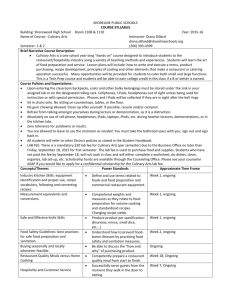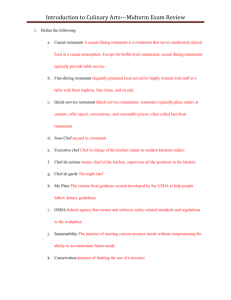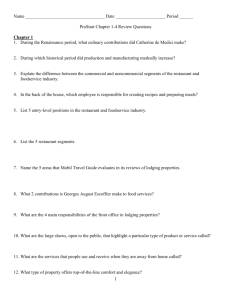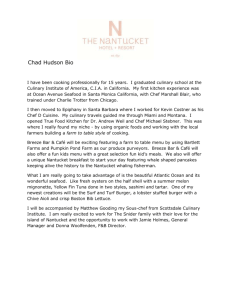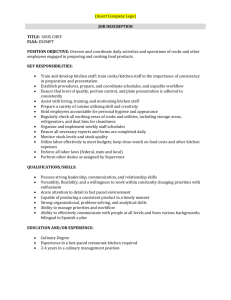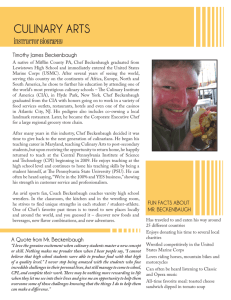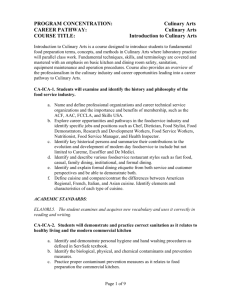Brainerd HIGH SCHOOL - McEachern High School
advertisement
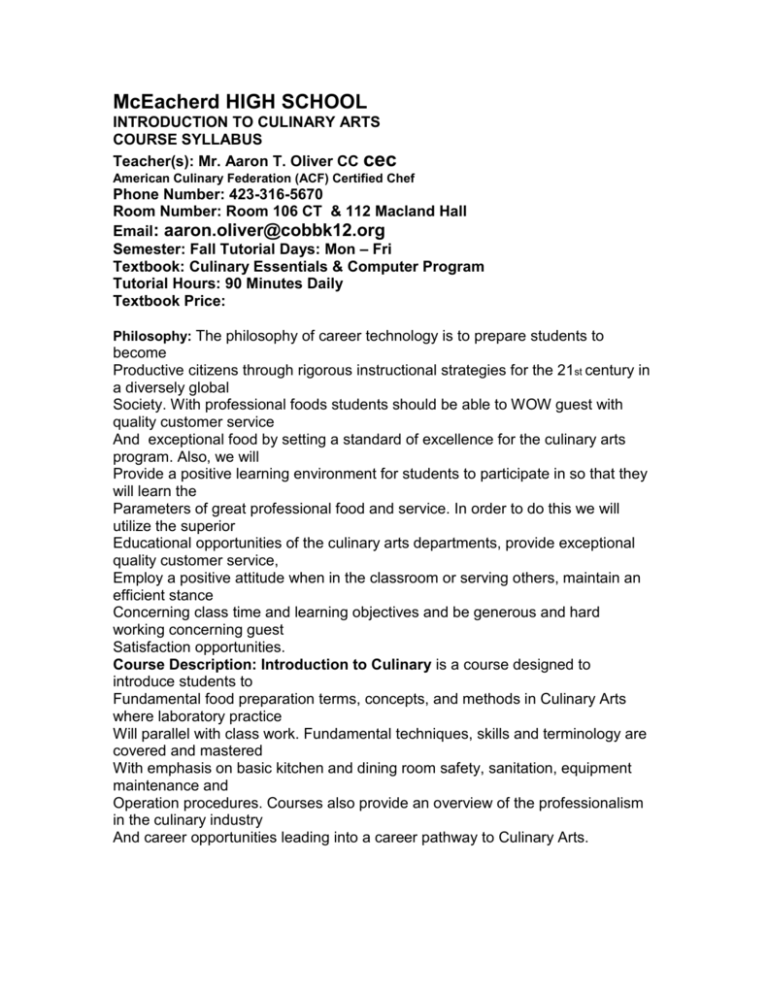
McEacherd HIGH SCHOOL INTRODUCTION TO CULINARY ARTS COURSE SYLLABUS Teacher(s): Mr. Aaron T. Oliver CC cec American Culinary Federation (ACF) Certified Chef Phone Number: 423-316-5670 Room Number: Room 106 CT & 112 Macland Hall Email: aaron.oliver@cobbk12.org Semester: Fall Tutorial Days: Mon – Fri Textbook: Culinary Essentials & Computer Program Tutorial Hours: 90 Minutes Daily Textbook Price: Philosophy: The philosophy of career technology is to prepare students to become Productive citizens through rigorous instructional strategies for the 21st century in a diversely global Society. With professional foods students should be able to WOW guest with quality customer service And exceptional food by setting a standard of excellence for the culinary arts program. Also, we will Provide a positive learning environment for students to participate in so that they will learn the Parameters of great professional food and service. In order to do this we will utilize the superior Educational opportunities of the culinary arts departments, provide exceptional quality customer service, Employ a positive attitude when in the classroom or serving others, maintain an efficient stance Concerning class time and learning objectives and be generous and hard working concerning guest Satisfaction opportunities. Course Description: Introduction to Culinary is a course designed to introduce students to Fundamental food preparation terms, concepts, and methods in Culinary Arts where laboratory practice Will parallel with class work. Fundamental techniques, skills and terminology are covered and mastered With emphasis on basic kitchen and dining room safety, sanitation, equipment maintenance and Operation procedures. Courses also provide an overview of the professionalism in the culinary industry And career opportunities leading into a career pathway to Culinary Arts. Georgia Performance Standards Performance standards provide clear expectations for Assessment, instruction, and student work. They define the level of work that demonstrates achievement Of the standards. The performance standards isolate and identify the skills needed to use the knowledge And skills to problem-solve reason, communicate, and make connections with other information. Tn. and Objectives for this course: . Students will examine and identify the history and philosophy of the Food service industry. a. Name and define professional organizations and career technical service organizations and the Importance and benefits of membership, such as ACF, AAC, FCCLA, and Skills USA. b. Explore career opportunities and pathways in the foodservice industry and identify specific jobs and Positions such as Chef, Dietician, Food Stylist, Food Demonstrators, Research and Development Workers, Food Service Workers, Nutritionist, Food Service Manager, and Health Inspector. c. Identify key historical persons and summarize their contributions to the evolution and development of Modern day foodservice to include but not limited to Crème, Escoffier and De Medici. d. Identify and describe various foodservice restaurant styles such as fast food, casual, family dining, Institutional and formal dining. e. Identify and explain formal dining etiquette from both service and customer perspectives and be able To demonstrate both. f. Define cuisine and compare/contrast the differences between American Regional, French, Italian, and Asian cuisine. Identify elements and characteristics of each type of cuisine. Students will demonstrate and practice correct sanitation as it relates to healthy living And the modern commercial kitchen a. Identify and demonstrate personal hygiene and hand washing procedures as defined in ServSafe Textbook. b. Identify the biological, physical, and chemical contaminants and prevention measures. c. Practice proper contaminant prevention measures as it relates to food preparation the commercial Kitchen. d. Discuss and practice cleanliness of kitchen equipment and facilities. e. Identify and examine pot and pan washing with four-compartment sinks and the use of sanitizers and Cleaning chemicals for manual and automatic dishwashing. f. Demonstrate the proper use and cleaning of an automatic dishwasher. g. Discuss pest control and management of infestations, Health Department inspections, and facility Requirements of commercial foodservice establishments. h. Identify and demonstrate proper receiving and storage principles such as FIFO, rotating inventory, And receiving temperatures. I. Identify the factors that affect the growth of food borne pathogens (i.e. FATTOM) and explain how time and temperature guidelines can reduce growth of microorganisms. j. List and demonstrate food handling, preparation, and storage techniques that prevent cross contamination Between raw and ready-to-eat foods and between animal and seafood, including sources Of other potentially hazardous food products. k. Discuss the concept of HACCP and the flow of food in a variety of foodservice establishments. Students will name and describe various fixed equipment and small wares associated With the commercial kitchen. a. List and describe the tools used for commercial food preparation, cooking, and serving and Demonstrate proper use. b. Identify and distinguish between a standard and convection oven, stoves, ranges, steamers, fryers, Refrigerators, freezers, slicers, food processors, coffee and tea brewing equipment, and food storage Equipment. Demonstrate proper use and cleaning of each. c. Identify and distinguish between the various mixers and small wares, demonstrating proper use and Cleaning. Students will analyze and examine fundamental safety skills and practices related to The commercial kitchen. a. Discuss principals of basic First Aid treatments for a foodservice environment including basic cuts, Lacerations, abrasions, punctures, CPR, food allergies, anaphylactic shock, Heimlich maneuver, and Minor burns. b. Examine and practice correct Fire Safety procedures using correct classifications of fire extinguishers, Hood suppression systems, and emergency evacuation routes. c. Practice and examine kitchen safety in the areas of falls, strains, sprains, and lifting using proper Techniques. d. Identify gas safety issues for gas ranges and ovens, including shut off valves and pilot lights. e. Examine and identify a Material Safety Data Sheet and explain their importance when handling Common foodservice chemicals. f. Identify and properly use and calibrate thermometers. Students will discuss and practice culinary math skills through recipe conversion and Measurements. a. Identify and master the use of different types of measuring tools including dry and liquid measuring Cups, measuring spoons, and portioning tools. b. Demonstrate proper use of a spring and balance scales. c. Identify procedures used to calculate the cost of a standardized recipe and cost per portion and Perform calculations. . Students will examine and perform all aspects of kitchen knife use and classic knife Skills. a. Identify the different types of knives, their use, parts, and components. B. Identify and practice proper knife safety procedures and rules. c. Demonstrate correct knife sharpening. d. Define and demonstrate the concept of “mise en place” in setting up a work cutting station. e. Demonstrate proper knife safety, cleaning, and storage. f. Demonstrate proper knife techniques for cuts as julienne, batonnet, small, medium, and large dice. Students will perform basic food preparations of poultry, meat, dairy, fruits, and Vegetables using proper commercial kitchen equipment and techniques to examine the Fundamental methods, as applied in a commercial kitchen. a. Identify basic food cooking methods such as dry heat, moist heat, and combination cooking. b. Demonstrate basic dry heat cooking methods including sauté, griddle, pan-fry, deep fry, baking, Roasting, and grilling. c. Demonstrate basic moist heat cooking methods including poaching, simmering, boiling, and steaming. d. Demonstrate basic combination cooking methods including stewing and braising. e. Compare and contrast a menu item using a microwave oven and conventional method. Students will examine and identify standardized recipes and their role in a Commercial kitchen. a. Define standardized recipe, the components of the recipe, and explain the reasons for use in Commercial kitchens. b. Identify recipe terminology including measurement abbreviations, instructions, and directions. c. Demonstrate the concept of recipe conversions by identifying and converting recipe formulas to Increase or decrease yields. d. Demonstrate the concept of recipe “mise en place” by identifying and assembling ingredients and Equipment for a specific recipe. e. Follow the written directions to prepare the recipe. Students will examine an introduction to nutrition including the six major classes of Nutrients, proteins, and carbohydrates: simple, complex, fats, vitamins, minerals and water. a. Discuss and develop knowledge of the importance of My Pyramid and examine how My Pyramid can Be misleading and complex due to cultural constraints, eating disorders, and food allergies. b. Examine the six major food groups, nutrient contributions of vitamins, minerals, and nutrient Variability within a group and daily recommended intake. c. Define a serving size, portion control, recommended serving size and balanced diet while maintaining A correct nutritional intake. d. Examine current trends and issues in food and nutrition, fad diets, proper weight loss techniques and How these fit into healthy menu options. Students will identify various food products used in a commercial foodservice Operation and list the proper handling and storage procedures for each. a. Identify proteins such as poultry, beef, pork, and seafood and demonstrate and examine the potential Contaminants associated with and proper handling procedures b. Identify types of fruits and vegetables and proper handling techniques. c. Identify types of grains and milled products and proper handling techniques. d. Identify and distinguish between herbs, spices, seasonings, and their uses. . Students will discuss and practice sound human relations and professionalismConcepts PROCEDURES for a career pathway in Culinary Arts employment. a. Identify a personalized resume and cover letter. b. Identify and demonstrate appropriate work ethics: attitude, appearance, attendance, teamwork, Character, productivity, organizational skills, communication, and respect. c. Define professionalism and professional appearance as it has developed throughout the history of Uniforms, presentation, and functionality. d. Identify the difference between personal and professional communication. e. Identify the five steps of the decision making process. Course Outline: Week 1: Introduction to Class, Class Procedures And Lab Procedures Human Relations and Professionalism Week 2:Careers in Culinary, History and Philosophy Week3:Fundamental Safety Skills and Practices Week4:Fundamental Safety Skills and Practices Week 5: Sanitation Procedure Week 6: Sanitation Procedures Week 7: Sanitation Procedures Week 8:Kitchen Equipment Identification and Use Week 9:Kitchen Equipment Identification and Use Week 10: Knife Usage and Knife Skills Week 11: Knife Usage and Knife Skills Week 12:Standardized Recipes, Measurements and Conversions Week 13:Food Identification, proper storage and Proper handling Week 14:Food Identification, proper storage and Proper handling Week 15: Introduction to basic food preparation Week 16: Introduction to basic food preparation Week 17: Introduction to nutrition Week 18: Final Examination/ Practical FCCLA: Family, Career, Community Leaders of America, founded in 1945, is a dynamic and effective National student organization that helps young men and women become leaders and address important Personal, family, work, and societal issues through family and consumer science education. Chapter Projects focus on a variety of youth concerns including teen pregnancy, parenting, family relationships, Substance abuse, peer pressure, environment, nutrition and fitness, intergenerational communication And career education. Involvement in FCCLA offers members the opportunity to expand their leadership Potential and develop skills for life - planning, goal setting, problem solving, decision making, and Interpersonal communication - necessary in the home and workplace. Each student that is enrolled in Culinary Arts will be considered a member of Skillsusa for that school Year. Hamilton County School System holds an Urban Affiliation with the organization allowing each Enrolled student to hold national and state membership. Students in the culinary arts program are Expected to be active members in the organization by participating in events and competitions. *Local Dues must be paid by the student. Uniform Policy: Students enrolled in the culinary program will be expected to maintain a professional Appearance. In accordance with ACF secondary standards each student will be REQUIRED to wear Professional chef’s attire during each lab session. This will include a pressed and clean white chef’s Jacket, hair restraint (chef hat) and nonskid, slip resistant closed in black shoes (open back, open toe, Skin exposed shoes will NOT be allowed). Each student will have a choice of renting a chef coat/hat or Purchasing there own personalized chef jacket with hat. Shoes have to be purchased by the student. Students will be allowed the first 10 minutes of class to change into there lab attire and will be graded by Chef instructor on attire/professionalism (grading rubric attached). Students that come to class not in Uniform will receive a zero for lab/professionalism on that day. Labs count as 20% of the overall grade. * Uniform policy is strictly enforced to ensure the safety of all students will working in the lab. Grading Scale Area Included in Area Percentage Class work/Daily Grade Daily in class activities, Group Assignments, Sponge, Written Work 20 % Final exam 15% Projects/Labs Lab activities, performance based Assignments, projects, Research Papers 30% Assessments Chapter Test, Skills, Unit Test 225% Work Ethic / Professionalism Promptness to class, teamwork, lab Attire, use of professional language, Respect of all, on task 5% Work Ethic/Professionalism Grade: Students are required to maintain a professional attitude while in class and exhibit good work ethics. Each student will start with 100 points for this particular area each time a student is tardy, break one of The class/lab rules, unprepared for class/lab (ex. improper lab attire, does not have notebook, Disrespectful to teacher/peer, etc.) You will receive a minus for each offense. At the end of the Semester all minuses will be added and deducted from the 100 points. This will determine your Work Ethic Grade. Example: 100 points given. Michael receives 28 –‘s throughout the semester. 100 points – 28(# of –‘s) = 72 (Michael’s work ethic grade for the semester) Required Materials for Class: Three Ring Binder w/ pockets, 8 Dividers with Tabs, Loose Leaf Paper, Pen (black or Blue), Pencils, Index Cards Tardy Policy: Students are expected to be in class on time daily. When tardy to class you MUST have A teacher/administrator pass for an excused tardy if not you will be receive an unexcused and result in The following consequences. 1st Tardy – Verbal / Written Warning by teacher 2nd Tardy – Teacher Assigned Detention 3rd Tardy – Parent Contact/ Conference and Teacher Assigned Detention 4th Tardy- Referral to Attendance Administrator Make up Work Policy: Students have the opportunity to make up all work missed due to an excused Absence . School policy allows three days after students return to class for all work to be turned in. Allowances will be made for more time for special cases. If a student does not make up missed Assignments within the allotted timeframe the grade will become a zero. Lab Supplies: Students are sometimes required to purchase items for class projects. Items are Normally between $ and rotate throughout the class population. McEachern LABORATORY PROCEDURES Report all accidents IMMEDIATELY to the Executive Chef, no Matter how minor. Business like atmosphere should be present in the lab at all times; Horseplay will not be tolerated. Refrain from the use of derogatory language in the lab. Ensure that you follow SAFETY and SANITATION GUIDELINES AT ALL TIMES!!!! Operate equipment only with instructor’s approval; being that there Is a clear understanding of proper use? Ensure that appropriate safety devices are on the equipment being Used at All times. Closed in, nonskid shoes must be worn on lab days to ensure safety. Pull back and restrain long hair; prevent hair from hanging on Shoulders CLASSROOM PROCEDURES Failure to follow any of the policies below will result in a deduction of points from Work ethnic/professionalism grade or after school detention!!!! Be in your assigned seat working on essential question/sponge Of the day when the tardy bell rings. (See student handbook Regarding the tardy policy.) In order to maintain elite sanitation standards, cleanliness is a Must in all areas of the classroom setting, and especially in the Kitchen labs. Remember the Three R’s: Respect for the Teacher Respect for others Respect for yourself Use ONLY professional language in this class; refrain from the Use of explicit/derogatory language. Put all electronic devices away before entering the classroom; If seen they will be confiscated. Refrain from personal grooming; examples includes but not Limited to combing/ brushing hair & applying makeup. Please discard any gum, candy, chips, cookies, juice, etc before Entering the classroom. Only water and healthy snacks Allowed!!!!!! BY SIGNING THIS DOCUMENT THE STUDENT AND PARENT ARE STATING THAT THEY READ AND UNDERSTAND THE STUDENT HANDBOOK IN ITS ENTIRERITY. STUDENTS WILL BE HELD ACCOUNTABLE FOR ANY MISCONDUCTTHAT LEADS TO EQUIPMENT/COMPUTER BREAKAGE AND INJURIES.IT IS MANDATORY THAT STUDENTS REPORT ANY EQUIPMENT THAT IS BROKEN PRIOR TO USE.THE TEACHER RESERVES THE RIGHT TO CHANGE OR ADJUST ANYSECTION OF THE COURSE RESUME AT ANY TIME DURING THESEMESTER TO MORE ADEQUATELY MEET THE NEEDS, ABILITIES AND INTEREST OF THE STUDENTS. Student Signature: ___________Date: _________ Parent/Guardian Signature: _________________Date: ______________ This form must be signed and returned to Chef Aaron T. Oliver before August 20, 2012. Signature page is worth 100 points.
